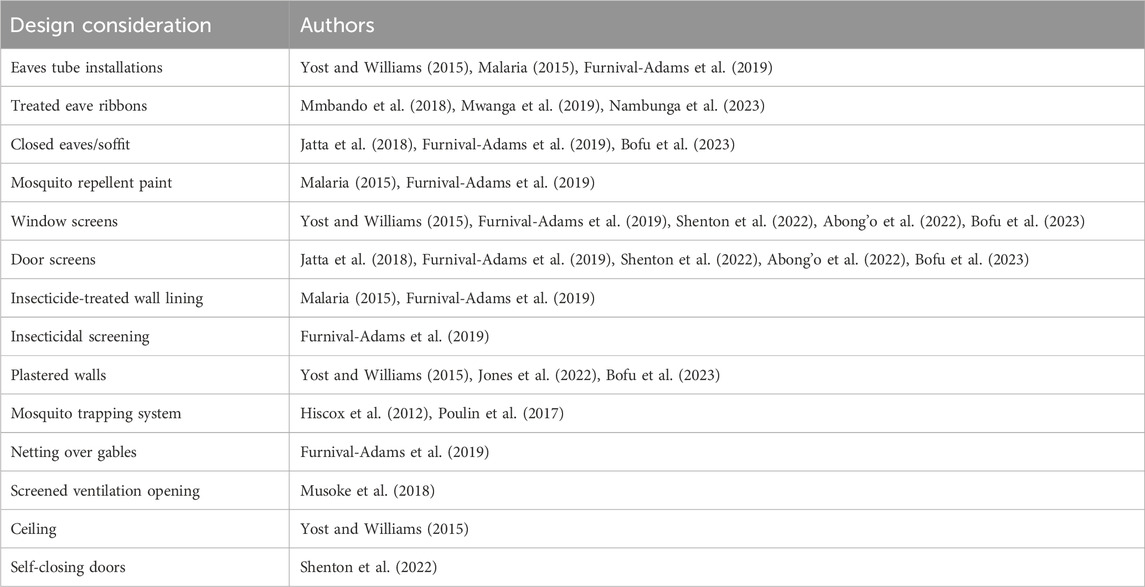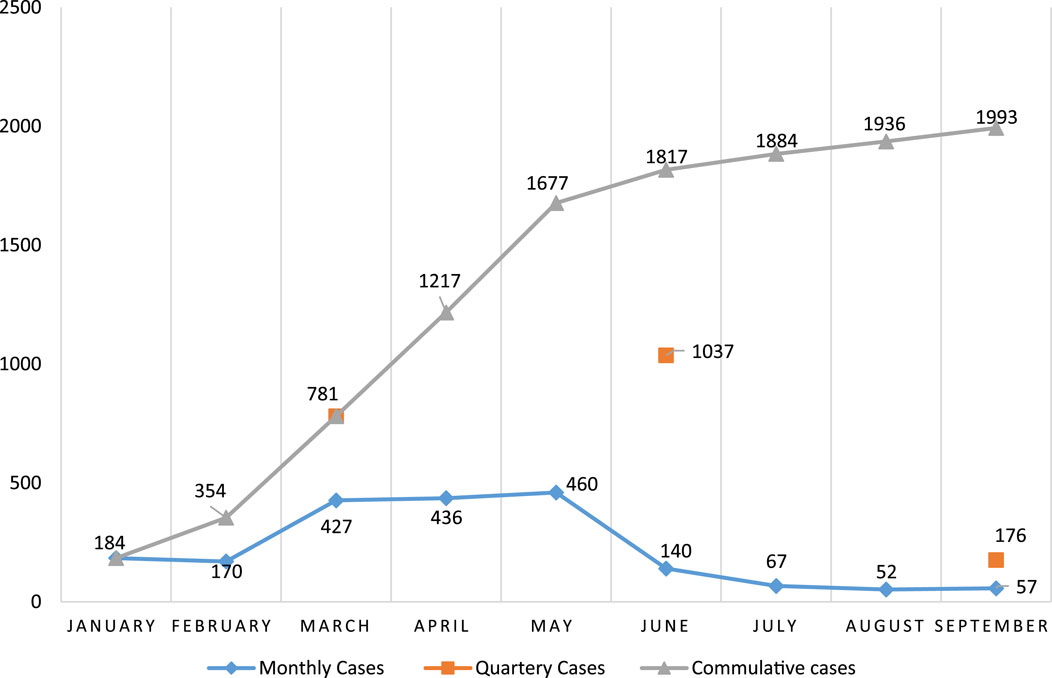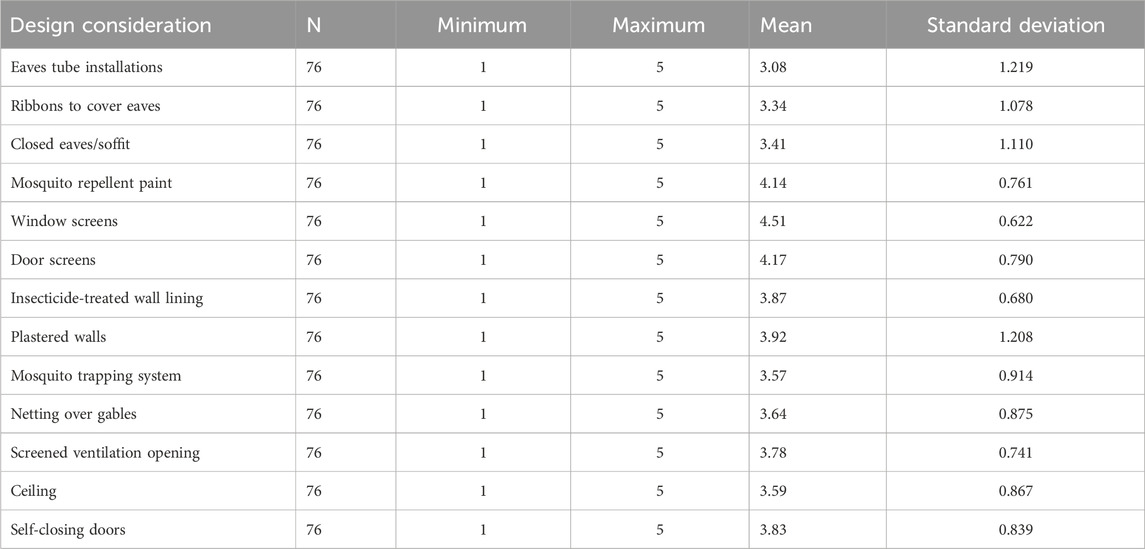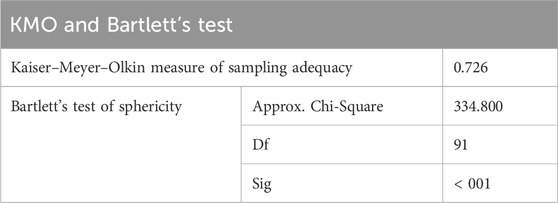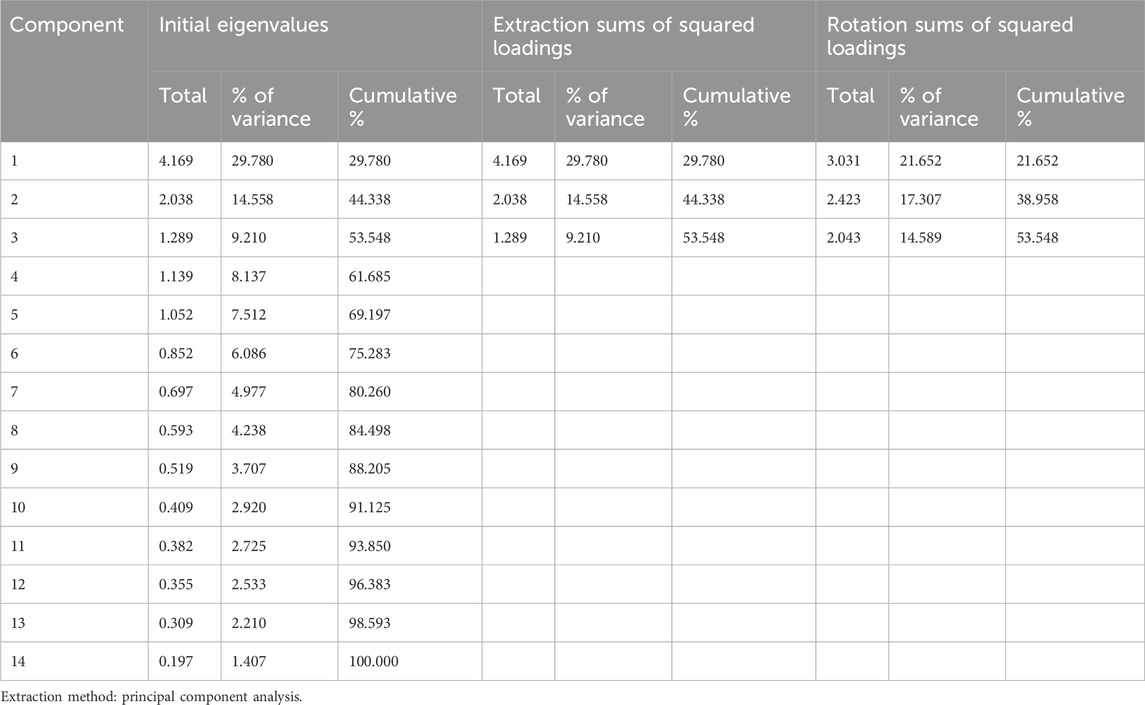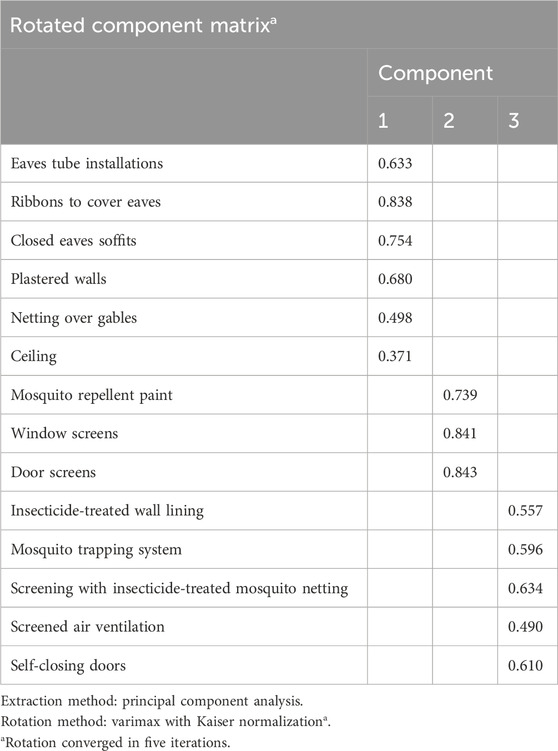- 1Department of Construction Management and Quantity Surveying, Faculty of Engineering and the Built Environment, University of Johannesburg, Johannesburg, South Africa
- 2Department of Environmental Health, Faculty of Health Sciences, Lusaka Apex Medical University, Lusaka, Zambia
Introduction: This research aimed to assess housing design consideration features and architects’ perceptions of their effectiveness in malaria prevention. Previous studies have highlighted various architectural design elements that can reduce mosquito entry into homes, thus contributing to malaria prevention. This study aims to build on these insights by evaluating specific design features and gathering professional opinions on their effectiveness.
Methods: The methodological approach adopted was quantitative, with data collected using a structured questionnaire containing closed-ended questions and a checklist. The observation checklist was used to ascertain mosquito entry reduction features incorporated in 208 systematically selected houses in Garneton East, Kitwe, Zambia. Additionally, a structured questionnaire containing fourteen key design features identified from the literature was administered to 76 architects purposively sampled to establish their perceptions of the effectiveness of these design factors in malaria prevention. Data collected was analyzed using descriptive statistics and exploratory factor analysis.
Results: The findings revealed that most houses needed to incorporate design features to reduce mosquito entry. The common features incorporated were ceilings (86.80%), screened air ventilation (59.80%), and window screens (54.40%). The use of window and door screens, as well as mosquito-repellent paint, were perceived as the most effective measures by the architects.
Discussion: The results suggest a keen awareness among architects regarding the efficacy of certain design features in malaria prevention. Despite this awareness, the implementation of these features in actual housing designs needs to be improved. This indicates a need for greater effort and adaptation in building regulations to promote the use of mosquito entry reduction features. Enhancing housing designs with these features can significantly reduce malaria morbidity and mortality. Therefore, it is recommended that building regulations be updated to support and encourage the incorporation of mosquito entry reduction features in housing designs.
1 Introduction
Malaria is a life-threatening disease caused by a parasite transmitted to humans through the bites of infected mosquitoes. According to the World Health Organization (2015), there were an estimated 229 million cases of malaria worldwide in 2019, with 409,000 deaths. The disease is mostly observed among children under the age of 5 in Sub-Saharan Africa. Poor housing design and construction has significantly contributed to the high malaria burden and morbidity observed worldwide currently, especially for countries in sub-Saharan Africa. While malaria prevention efforts have largely focused on the use of insecticide-treated bed nets, indoor residual spraying, and antimalarial drugs, housing design also plays a crucial role in preventing malaria transmission (Tusting et al., 2015). However, despite evidence that well-constructed and designed houses can reduce the risk of contracting malaria, housing design improvement is rarely included in malaria control and interventions.
The World Health Organization (WHO) has recommended and endorsed the use of anti-vector procedures such as indoor residual spraying, use of long-lasting insecticide-treated bed nets, and destruction of larval breeding sites as malaria prevention measures among other things (Cheikh et al., 2013). The challenges associated with the current malaria prevention measures include increases in drug-resistant parasites, increase in insecticide-resistant mosquitoes, and poorly constructed housing (Emmanuel et al., 2017). According to Furnival-Adams et al. (2021), factors such as ventilation, lighting, building materials, and landscaping can all influence mosquito breeding and survival and therefore influence the spread of malaria. Holding that by implementing appropriate design features, it may be possible to reduce the incidence of malaria in the affected communities.
Since the beginning of the 21st century, most malaria prevention methods, as aforementioned, have centered on the use of insecticides and mosquito nets. However, despite these methods being relatively successful, the disease burden remains intractable in many Sub-Saharan countries, making it a major cause of morbidity and mortality. It is worth noting that the most used or applied malaria prevention measures, which are indoor residual spraying (IRS) and insecticide-treated nets (ITNs), can be effectively used and applied to prevent malaria only when the malaria vectors have already entered buildings, houses, or indoors, but they do not prevent the entry of malaria vectors into buildings (Tizifa et al., 2018). Therefore, there is a need for intervention in malaria prevention that will at least minimize the entry of malaria vectors in the houses (Wangdi et al., 2018). The main purpose of this study was to assess housing design consideration features and architects’ perception on the effectiveness of features in malaria prevention. Studies have been conducted on malaria prevention through housing design (Tatem et al., 2013; Gachelin et al., 2018; Furnival-Adams et al, 2020). However, the novelty of this research is that it is among the few studies focusing on establishing architects’ perception on the efficacy of various housing design features in the reduction of mosquito entry and consequently malaria incidences. The architect’s perception is very important considering their role in influencing designs; they are usually the first point of contact for homebuilders; therefore, their expertise has potential to influence the extent to which design features can be incorporated in building designs.
2 Housing and malaria
A house is a physical building that not only provides its residents with shelter but also uses up land; it necessitates the use of physical services like water and sewage and requires that households utilize social services (Chisumbe et al., 2024). Alemu (2010), p. 13 shared the same perception by defining housing “as a physical shelter fixed in a place and intended for human habitation including all services desired for the physical health and social well-being of the family and the individual.” Okoro et al. (2016) mentioned that the shortage of adequate housing and associated services has a negative impact on people’s health and safety. Good housing design has been identified as a key pillar of public health; however, it has not fully been considered in malaria control. For instance, it has been argued that most mosquito bites happen indoors at night in most countries of Sub-Saharan Africa; this underscores the need for ensuring mosquito-proof homes (Jatta et al., 2018). Well-built housing can help protect against malaria in many African countries; however, house design has been largely neglected as a potential malaria control tool, due to reliance on other interventions (Furnival-Adams et al., 2020).
Therefore, investigating housing design considerations that prevent malaria transmission can directly contribute to the reduction of the disease burden and improve the health and wellbeing of people in malaria-affected regions and further, it can complement existing malaria control measures such as insecticide-treated bed nets and IRS. By addressing both human behavior and environmental factors that contribute to malaria transmission through housing design, a comprehensive approach to malaria prevention can be established. Although housing interventions have been widely used for malaria control in the past (Gachelin et al., 2018), as the global malaria prevention community promoted IRS in the 1940s as a simple solution, providing malaria protection through housing design was not widely considered.
Literature evidence indicates that there is a relationship between housing quality and malaria (Boyd, 2013), positing that an improvement in housing design may contribute to malaria control and elimination by reducing entry of malaria vectors into the house and thus exposure to biting (Tusting et al., 2015). According to Knudse and Seidlein (2014), housing improvements or modifications may be an important strategy for malaria prevention intervention as intersectoral approaches to malaria control and elimination are increasingly encouraged. According to Tatem et al. (2013), housing quality is an important risk factor for malaria infection across the Sub-Saharan African region, with a strong association observed between housing quality and malaria, similar to that observed between ITN use and malaria. Improved housing should be considered a promising intervention for malaria control and elimination and long-term prevention measure. In Gambia, a lower incidence of malaria cases was reported among occupants of improved housing compared to unimproved houses (O’Neill et al., 2015).
2.1 Design considerations
Housing design considerations refer to the various factors and elements that architects, builders, and designers take into account when planning and constructing residential buildings including aspects of functionality, aesthetics, safety, comfort, sustainability, and accessibility (Kuldeep, 2019). Inadequately constructed housing allows easy entry of mosquitoes into the indoor living environment. Features such as open eaves, unscreened windows and doors, mud or thatched walls and roofs, and lack of ceilings are all risk factors for mosquito entry. Simple modifications to housing designs such as sealing eaves, window and door screening, self-closing doors, and insecticidal screening significantly reduce mosquito entry into the home, thereby decreasing the risk of infection for all residents.
The housing design features or considerations identified as being effective in malaria prevention, as espoused in this study, were informed by the works of Hiscox et al. (2012); Malaria (2015); Yost and Williams (2015); Poulin et al. (2017), Jatta et al. (2018); Mmbando et al. (2018); Musoke et al. (2018); Furnival-Adams et al. (2019); Mwanga et al. (2019); Abong’o et al. (2022); Shenton et al. (2022); Bofu et al. (2023), as well as Nambunga et al. (2023) as shown in Table 1.
3 Malaria trends in Zambia
According to the World Health Organization (2019), despite being recognized internationally for its ambitious goal of malaria elimination and for having attained pre-elimination levels in Southern Province, Zambia, as a whole remains an endemic malaria country, with the entire population considered to be at risk of contracting malaria. Zambia is among the 20 countries with the highest incidence of malaria and mortality globally, and the country carries 2% of the global malaria case burden, and 6.1% of the case burden in observed in East and Southern Africa. However, the Zambian Government through the Zambian National Malaria Control Program has made great progress in the fight against malaria. The country has solid, consistent, and coordinated policies; strategies; and guidelines for malaria control, with the government prioritizing malaria in both the National Health Strategic Plan and the National Development Plan.
Like in many parts of Africa and the world at large where malaria is a burden, in Zambia, the key malaria prevention, control, and management strategies to prevent the disease are vector control using IRS and promotion of ownership and use of insecticide-treated nets (Chanda et al., 2013). However, due to the resistance of the malaria vector to the chemicals used in IRS and ITNs, the government through national development plan programs wants to promote malaria prevention through housing design or the built environment. These can be in the form of housing modifications and design, which can safeguard against malaria by reducing the contact between mosquito vectors and human hosts (Stevenson et al., 2016). This paper advances that the role of architects as designers is key in achieving the desired goal.
4 Methods and material
The methodological approach adopted for this study was quantitative, with data collected using a structured questionnaire containing closed-ended questions as well as a checklist. An observation checklist was used in ascertaining mosquito entry reduction features incorporated in houses of Garneton East, Kitwe, Zambia, whereas a structured questionnaire containing closed-ended questions was used in establishing architect’s perception on the design factors considered effective in reduction of mosquito entry in houses. For measuring the respondents’ agreement levels, statements were rated on a 5-point Likert scale. The scale of 1 to 5 was used, where 1 = strongly disagree (≥ 1.00 and ≤ 1.80), 2 = disagree (≥ 1.81 and ≤ 2.60), 3 = neutral (≥ 2.61 and ≤ 3.40), 4 = agree (≥ 3.41 and ≤ 4.20), and 5 = strongly agree (≥ 4.21 and ≤ 5.00).
Garneton East, which is the study area, is a planned settlement comprising mostly formal housing built in accordance with the planning and building regulations. A total of 208 houses were systematically sampled and observed in ascertaining the presence of mosquito entry reduction/prevention design features. More so, in establishing architect’s perception, 76 architects were sampled and included in the study. Data collected were analyzed using descriptive statistics as well as exploratory factor analysis (EFA). Factor analysis was performed in exploring the design features considered effective by architects in malaria prevention.
5 Results
An assessment that aimed at ascertaining the prevalence of malaria cases in Garneton was carried out. Data were collected from the clinic, which services some of the residents in the study area. The records showed an incidence of 1,994 malaria cases over a 9-month period from January to September 2023. The highest number of cases was recorded from March to May, as shown in Figure 1.
Furthermore, a survey was carried out aimed at ascertaining the inclusion of mosquito entry reduction features in houses as a strategy for malaria prevention. A total of 208 houses in Garneton East, Kitwe (study area), were considered in the survey. The findings revealed that most houses checked had not implemented the key design features in reduction of mosquito entries. The common design features considered were ceilings (86.80%), plastered walls (65.70%), screened air ventilations (59.80%), window screens (54.40%), as well as closed eaves/soffits (49.50%). Only 31.9% of the houses surveyed had used mosquito repellent paint, and the summary of the survey results is shown in Figure 2.
5.1 Perception on design factors
An assessment was carried out to ascertain architect’s perception on the effectiveness of identified design considerations in mosquito reduction and consequently malaria prevention. The use of window screens, mosquito repellent paint, as well as door screens was perceived to be the most effective features in mosquito reduction, as denoted by the mean scores in the range of 4.14–4.51. Equally, the standard deviation scores were well below 1, suggesting a common perception. Overall, there was an agreement on most of the features’ effectiveness in mosquito reduction, with the exception of the use of eaves tube installations, ribbon covers over eaves, and closed eaves/soffit as shown in Table 2. On the effectiveness of closing eaves and soffits though the mean score was 3.41, the standard deviation suggested lack of consensus or common perception. Due to lack of consensus for the three design features, a decision was made to include them for further analysis (exploratory factor analysis).
An EFA was conducted to assess the uni-dimensionality and reliability of housing design features. Principal components with varimax rotation were specified as the extraction and rotation methods, respectively. The results revealed a KMO value of 0.726 and the Bartlett’s test of sphericity, which is significant (p = 0.001), as shown in Table 3. This indicated that the factor analysis was appropriate (Musonda, 2012; Chisumbe et al., 2024).
A PCA revealed that all items clearly loaded on three components, with loading factors for most being above 0.6, and eigenvalues exceeding 1, explaining 29.780%, 14.558%, and 9.210% of the variance. Furthermore, an inspection of the scree plot revealed a clear break after the third component. Using Cattell’s (1966) scree test, it was decided upon to retain three components. This was further supported by the results of a parallel analysis. The three-component solution explained 53.548% of the variance, with Component 1 contributing 29.780%, Component 2 contributing 14.558%, and Component 3 contributing 9.210%, as shown in Table 4. The three components’ structure appeared to fit the data well; therefore, all the 13 items retained.
The rotated matrix based on three-factor extraction revealed that all the 13 items were loaded on three components. The factor loadings for all items were greater than the recommended value of 0.4 (Hair et al., 2008; Field, 2009), except for one design feature, the ceiling, which had a value of 0.371, as shown in Table 5. Enough evidence of convergent validity was provided for this construct; hence, the items were retained.
Furthermore, the corrected item–total correlation was greater than the recommended cut-off value of 0.3, suggesting that the items provided a good measure of the perceived effectiveness. Cronbach’s alpha value was greater, 0.7 at 0.800, as shown in Table 6, denoting an acceptable internal reliability (Aigbavboa, 2014), an indication that factor analysis could be conducted on the data.
6 Discussion
Records on the prevalence of malaria cases revealed the presence of malaria in the study area, aligning with the observations of other scholarly works on the incidences of malaria. Ma et al. (2023) asserted that Zambia has a high incidence of malaria, which seriously endangers people’s life and health and increases the social and economic burden of the affected communities to a certain extent. A study by Nawa et al. (2019) equally confirmed an increase in malaria cases in Zambia.
Furthermore, a survey of sampled houses revealed a lack of incorporation of key design features aimed at reducing the entry of mosquitoes into houses. These findings affirm Leandro-Reguillo et al. (2015)’s assertion that despite the huge potential which architecture has as an important tool in malaria elimination, malaria-preventive housing features through architecture (design) are barely incorporated in the housing. Similarly, Jawara et al. (2018) had earlier established that despite compelling evidence that modern housing design provides protection against malaria, houses in endemic areas are still commonly porous to mosquitoes. Ma et al. (2023); Nawa et al. (2019) argues that in Zambia, efforts have focused more on the ITNs as well as IRS, as the most common interventions in malaria prevention. Malaria risk and endemicity are strongly linked to the quality of housing and human settlements. The eradication of malaria in regions which were previously endemic has been attributed to the improvements in housing quality and human settlements (Carter and Karunaweera, 2020). Unfortunately, housing design is one aspect that has not been fully integrated in malaria prevention strategies in Zambia, as well as other Sub-Saharan African countries. Improving housing and the human settlements is one way to enable a more integrated and long-term strategy to malaria prevention across all endemic areas (Tusting et al., 2015).
Strikingly, the study established that the architects seem to understand the effectiveness of incorporating design features in malaria prevention despite such features not being evident in the surveyed houses. Their perception and understanding on the significance of window screens, mosquito repellent paint, as well as door screens in mosquito reduction and consequently malaria prevention aligns with literature evidence. Abong’o et al. (2022) advances that screening of eaves, doors, and windows has a significant impact in reducing the entry of mosquitoes, though they suggested the possibility of such features influencing the construction cost. Bofu et al. (2023) underscored the importance of design features such as window and door screens in ensuring houses to be malaria-proof. Likewise, Yost and Williams (2015) posited that features like open eaves, unscreened windows and doors, mud or thatch walls and roofs, and lack of ceilings are all risk factors for mosquito entry. Equally, Jatta et al. (2018) asserted that screened doors decrease the number of mosquitoes entering houses by 89%–93%, marking a substantial reduction in house entry. This study suggests that architects know the importance of incorporating design features in housing as a strategy for malaria prevention, and these findings further suggest that if architects are included in the intervention programs, perhaps cases of malaria could be lowered.
7 Conclusion
The collective evidence from the reviewed literature underscores the pivotal role of housing in the malaria prevention landscape, yet it highlights a significant oversight in engaging key stakeholders, particularly architects and urban planners, in malaria reduction strategies. This oversight not only diminishes the potential impact of these strategies but also overlooks opportunities for innovative design solutions that could further reduce malaria transmission.
This study’s findings conclusively demonstrate that architects are keenly aware of the efficacy of specific design features in reducing mosquito entry and, by extension, malaria transmission. These features include, but are not limited to, window screens, mosquito repellent paint, and door screens. Despite this knowledge, there remains a conspicuous gap in the practical application of such design elements in the current housing stock, particularly in regions where malaria prevalence is high.
Accordingly, this study strongly advocate for the following recommendations:
i. Integrated malaria prevention strategies: malaria reduction programs must actively include architects, urban planners, and local authorities from the onset. Such collaboration can ensure the implementation of design features scientifically proven to reduce mosquito entry into living spaces, thereby mitigating malaria transmission risk.
ii. Policy and regulation development: local governments and public health authorities should work together to establish policies and building codes that mandate the incorporation of malaria-preventive design features in new housing developments, especially in malaria-endemic regions.
iii. Cost–benefit analysis: further research is needed to evaluate the economic implications of integrating these malaria prevention design features into housing. This includes assessing upfront costs against long-term benefits, such as reduced malaria incidence and, consequently, lower healthcare costs and improved public health outcomes.
iv. Public awareness and education: efforts should be made to increase public awareness about the importance of architectural design in malaria prevention. Homeowners and builders alike should be educated on the benefits of incorporating specific design features that reduce mosquito entry, emphasizing that such measures are not only effective but also potentially cost-saving in the long run.
v. Pilot projects and case studies: implementing pilot projects that integrate these design features into housing within malaria-endemic areas. Documenting and disseminating the outcomes of these projects can provide valuable case studies that demonstrate the feasibility and effectiveness of such approaches.
By addressing these recommendations, the public can harness the full potential of architectural design in the ongoing fight against malaria, moving toward safer, healthier, and more resilient communities. Though interesting and valuable findings have emerged from this study, they are not without limitations. The limitation was that no experiment was conducted in assessing the efficacy of the design features, and instead the study relied on empirical evidence drawn from an extensive literature review of other scholarly works on housing and malaria.
Data availability statement
The datasets presented in this article are not readily available because data used for this study are not publicly available for ethical reasons. However, it can be made available on request from the corresponding author. Requests to access the datasets should be directed to Y2xlY2hpc3VtYmVAZ21haWwuY29t.
Ethics statement
Ethical approval for this study was obtained from Lusaka Apex Medical University Biomedical Ethics Committee IRB No. 00001131, FWA No. 00029892 and Protocol Approval No. 00543-23. The study was conducted in accordance with the local legislation and institutional requirements. The participants consented to participate in this study.
Author contributions
SC: conceptualization, formal analysis, methodology, and writing–original draft. CA: conceptualization, funding acquisition, resources, supervision, validation, and writing–review and editing. OA: conceptualization, methodology, validation, and writing–original draft. GM: conceptualization, formal analysis, investigation, methodology, and writing–original draft.
Funding
The author(s) declare that no financial support was received for the research, authorship, and/or publication of this article.
Acknowledgments
Special appreciation goes to the CIDB Centre for Excellence and Sustainable Human Settlement and Construction Research, University of Johannesburg, for the support in preparing this paper.
Conflict of interest
The authors declare that the research was conducted in the absence of any commercial or financial relationships that could be construed as a potential conflict of interest.
Publisher’s note
All claims expressed in this article are solely those of the authors and do not necessarily represent those of their affiliated organizations, or those of the publisher, the editors, and the reviewers. Any product that may be evaluated in this article, or claim that may be made by its manufacturer, is not guaranteed or endorsed by the publisher.
References
Abong’o, B., Gimnig, J. E., Omoke, D., Ochomo, E., and Walker, E. D. (2022). Screening eaves of houses reduces indoor mosquito density in rural, western Kenya. Malar. J. 21 (1), 377. doi:10.1186/s12936-022-04397-y
Aigbavboa, C. O. (2014). An integrated Beneficiary centered satisfaction model for publicly funded housing schemes in South Africa. Ph.D. Thesis. South Africa: University of Johannesburg.
Alemu, G. H. (2010). An assessment of urban housing supply and affordability in Jimma town: with special reference to condominium housing. Available at: https://www.grin.com/document/279819.
Bofu, R. M., Santos, E. M., Msugupakulya, B. J., Kahamba, N. F., Swilla, J. D., Njalambaha, R., et al. (2023). The needs and opportunities for housing improvement for malaria control in southern Tanzania. Malar. J. 22 (1), 69. doi:10.1186/s12936-023-04499-1
Boyd, F. M. (2013). The influence of obstacles unconsciously erected against anophelines (housing and screening) upon the incidence of malaria. American Society of Tropical Medicine and Hygiene.
Carter, R., and Karunaweera, N. D. (2020). The role of improved housing and living environments in malaria control and elimination. Malar. J. 19 (1), 385. doi:10.1186/s12936-020-03450-y
Cattell, R. B. (1966). The scree test for the number of factors. Multivariate Behav. Res. 1 (2), 245–276. doi:10.1207/s15327906mbr0102_10
Chanda, E., Kamuliwo, M., Steketee, R. W., Macdonald, M. B., Babaniyi, O., and Mukonka, V. M. (2013). An overview of the malaria control programme in Zambia. Int. Sch. Res. Notices 2013, 1–8. doi:10.5402/2013/495037
Cheikh, S., Mo, N., and Rogier, C. (2013). The changes in mosquito vector behaviour and the emerging resistance to insecticides will challenge the decline of malaria. Clin. Microbiol. Infect. doi:10.1111/1469-0691.12314
Chisumbe, S., Aigbavboa, C., Thwala, W., and Mwanaumo, E. (2024). Modelling stakeholders’ capacity for urban housing development: a developing country’s perspective. Baltic J. Real Estate Econ. Constr. Manag. 12 (1), 1–17. doi:10.2478/bjreecm-2024-0001
Chisumbe, S., Aigbavboa, C. O., Mwanaumo, E., and Thwala, W. D. (2024). A neoliberal framework for urban housing development in the global South. Emerald Publishing Limited. doi:10.1108/9781837970346
Emmanuel, O. I., Peter, A. F., Odeh, U. P., and Uche, A. J. (2017). Challenges of malaria elimination in Nigeria; A review. Mortality 17, 19. doi:10.11648/j.ijidt.20170204.14
Field, A. (2009). Correlation: bivariate correlation. Field: a discovering statistics using SPSS. London: British Library, 175–179.
Furnival-Adams, J., Olanga, E. A., Napier, M., and Garner, P. (2019). Housing interventions for preventing malaria. Cochrane Database Syst. Rev. 2019 (8). doi:10.1002/14651858.cd013398
Furnival-Adams, J., Olanga, E. A., Napier, M., and Garner, P. (2020). House modifications for preventing malaria. Cochrane Database Syst. Rev. 2020. doi:10.1002/14651858.cd013398.pub2
Furnival-Adams, J., Olanga, E. A., Napier, M., and Garner, P. (2021). House modifications for preventing malaria. Cochrane Database Syst. Rev. 2021 (1). doi:10.1002/14651858.cd013398.pub3
Gachelin, G., Garner, P., Ferroni, E., Verhave, J. P., and Opinel, A. (2018). Evidence and strategies for malaria prevention and control: a historical analysis. Malar. J. 17, 96–18. doi:10.1186/s12936-018-2244-2
Hair, J. F., Anderson, R. E., and Tatham, R. L. (2008). Black, W.C. Multivariate data analysis. Upper Saddle River: Prentice Hall Publisher.
Hiscox, A., Maire, N., Kiche, I., Silkey, M., Homan, T., Oria, P., et al. (2012). The SolarMal Project: innovative mosquito trapping technology for malaria control. Malar. J. 11, 455–O52. doi:10.1186/1475-2875-11-s1-o45
Jatta, E., Jawara, M., Bradley, J., Jeffries, D., Kandeh, B., Knudsen, J. B., et al. (2018). How house design affects malaria mosquito density, temperature, and relative humidity: an experimental study in rural Gambia. Lancet Planet. Health 2 (11), e498–e508. doi:10.1016/s2542-5196(18)30234-1
Jawara, M., Jatta, E., Bell, D., Burkot, T. R., Bradley, J., Hunt, V., et al. (2018). New prototype screened doors and windows for excluding mosquitoes from houses: a pilot study in rural Gambia. Am. J. Trop. Med. Hyg. 99 (6), 1475–1484. doi:10.4269/ajtmh.18-0660
Jones, C., Matta, A., Pinder, M., D’Alessandro, U., Knudsen, J., and Lindsay, S. W. (2022). House screening for malaria control: views and experiences of participants in the Roo Pf s trial. Malar. J. 21 (1), 294. doi:10.1186/s12936-022-04321-4
Knudsen, J., and Seidlein, L. (2014). Healthy homes in tropical zones: improving rural housing in Asia and Africa. Stuttgart: Edition Axel Menges.
Kuldeep, B. (2019). Design considerations for different house types. Available at: www.linkedin.com.
Leandro-Reguillo, P., Thomson-Luque, R., Monteiro, W. M., and De Lacerda, M. V. (2015). Urban and architectural risk factors for malaria in indigenous Amazonian settlements in Brazil: a typological analysis. Malar. J. 14, 284–314. doi:10.1186/s12936-015-0806-0
Ma, Z., Xia, B., and Xie, W. (2023) “Current status and challenges of malaria in Zambia,” in The 2nd international conference on biological engineering and medical science.
Malaria, R. B. (2015) “Housing and malaria consensus statement,” in Vector control working group. New York: Roll Back Malaria Partnership.
Mmbando, A. S., Ngowo, H., Limwagu, A., Kilalangongono, M., Kifungo, K., and Okumu, F. O. (2018). Eave ribbons treated with the spatial repellent, transfluthrin, can effectively protect against indoor-biting and outdoor-biting malaria mosquitoes. Malar. J. 17 (1), 368–414. doi:10.1186/s12936-018-2520-1
Musoke, D., Miiro, G., Ndejjo, R., Karani, G., Morris, K., Kasasa, S., et al. (2018). Malaria prevention practices and associated environmental risk factors in a rural community in Wakiso district, Uganda. PLoS One 13 (10), e0205210. doi:10.1371/journal.pone.0205210
Musonda, I. (2012). Construction health and safety (H&S) performance improvement-A client-centred model. South Africa: Univ. Johannesbg.
Mwanga, E. P., Mmbando, A. S., Mrosso, P. C., Stica, C., Mapua, S. A., Finda, M. F., et al. (2019). Eave ribbons treated with transfluthrin can protect both users and non-users against malaria vectors. Malar. J. 18, 314–14. doi:10.1186/s12936-019-2958-9
Nambunga, I. H., Shirima, G. G., Mbarawa, A., Ferguson, H. M., Okumu, F. O., Viana, M., et al. (2023). The impact of treated eave ribbons in reducing malaria transmission; A mathematical modelling perspective.
Nawa, M., Hangoma, P., Morse, A. P., and Michelo, C. (2019). Investigating the upsurge of malaria prevalence in Zambia between 2010 and 2015: a decomposition of determinants. Malar. J. 18, 61–10. doi:10.1186/s12936-019-2698-x
O’Neill, S., Gryseels, C., Dierickx, S., Mwesigwa, J., Okebe, J., d’Alessandro, U., et al. (2015). Foul wind, spirits and witchcraft: illness conceptions and health-seeking behaviour for malaria in the Gambia. Malar. J. 14, 167–210. doi:10.1186/s12936-015-0687-2
Okoro, C. S., Musonda, I., and Agumba, J. (2016). “Identifying barriers to urban residential infrastructure development: A literature review,” Proceedings of the International Conference on Infrastructure Development in Africa, Yogyakarta, Indonesia, 10–12.
Poulin, B., Lefebvre, G., Muranyi-Kovacs, C., and Hilaire, S. (2017). Mosquito traps: an innovative, environmentally friendly technique to control mosquitoes. Int. J. Environ. Res. public health 14 (3), 313. doi:10.3390/ijerph14030313
Shenton, F. C., Jawara, M., Carrasco-Tenezaca, M., Knudsen, J., D’Alessandro, U., and Lindsay, S. W. (2022). The durability, functionality and acceptability of novel screened doors and windows after 4 years of use in a Gambian village: a cross-sectional survey. Malar. J. 21 (1), 64. doi:10.1186/s12936-022-04087-9
Stevenson, J. C., Pinchoff, J., Muleba, M., Lupiya, J., Chilusu, H., Mwelwa, I., et al. (2016). Spatio-temporal heterogeneity of malaria vectors in northern Zambia: implications for vector control. Parasites vectors 9, 510–515. doi:10.1186/s13071-016-1786-9
Tatem, A. J., Gething, P. W., Smith, D. L., and Hay, S. I. (2013). Urbanization and the global malaria recession. Malar. J. 12, 133–211. doi:10.1186/1475-2875-12-133
Tizifa, T. A., Kabaghe, A. N., McCann, R. S., van den Berg, H., Van Vugt, M., and Phiri, K. S. (2018). Prevention efforts for malaria. Curr. Trop. Med. Rep. 5, 41–50. doi:10.1007/s40475-018-0133-y
Tusting, L. S., Ippolito, M. M., Willey, B. A., Kleinschmidt, I., Dorsey, G., Gosling, R. D., et al. (2015). The evidence for improving housing to reduce malaria: a systematic review and meta-analysis. Malar. J. 14, 209–212. doi:10.1186/s12936-015-0724-1
Wangdi, K., Furuya-Kanamori, L., Clark, J., Barendregt, J. J., Gatton, M. L., Banwell, C., et al. (2018). Comparative effectiveness of malaria prevention measures: a systematic review and network meta-analysis. Parasites vectors 11, 210–213. doi:10.1186/s13071-018-2783-y
World Health Organization (2015). Global technical strategy for malaria 2016-2030. Geneva, Switzerland: World Health Organization.
World Health Organization (2019). World malaria report 2020. Available at: https://www.severemalaria.org/countries/zambia.
Keywords: design features, housing, malaria, mosquito, prevention
Citation: Chisumbe S, Aigbavboa C, Akinradewo O and Mukeya G (2024) Effectiveness of housing design features in malaria prevention: architects’ perspective. Front. Built Environ. 10:1427836. doi: 10.3389/fbuil.2024.1427836
Received: 20 May 2024; Accepted: 25 June 2024;
Published: 23 July 2024.
Edited by:
Mitja Košir, University of Ljubljana, SloveniaReviewed by:
Evandro Eduardo Broday, Federal University of Technology. Campus Ponta Grossa, BrazilMarianna Brodach, Moscow Architectural Institute, Russia
Copyright © 2024 Chisumbe, Aigbavboa, Akinradewo and Mukeya. This is an open-access article distributed under the terms of the Creative Commons Attribution License (CC BY). The use, distribution or reproduction in other forums is permitted, provided the original author(s) and the copyright owner(s) are credited and that the original publication in this journal is cited, in accordance with accepted academic practice. No use, distribution or reproduction is permitted which does not comply with these terms.
*Correspondence: Sampa Chisumbe, Y2xlY2hpc3VtYmVAZ21haWwuY29t
 Sampa Chisumbe
Sampa Chisumbe Clinton Aigbavboa1
Clinton Aigbavboa1 Opeoluwa Akinradewo
Opeoluwa Akinradewo